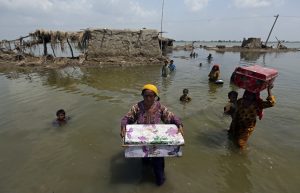In southern Pakistan, Basheera can’t return home. She works for my family in Khairpur and would often take a wagon, rickshaw, or bike back to her village in Sindh province’s Khairpur Mirs district. Following Pakistan’s recent floods, her village drowned and cannot be accessed by land. In our mostly arid district, we must now borrow a run-down fisherman’s boat to access what remains of Basheera’s village: a few broken-down structures, drowned homes, lost crops, submerged graves of our ancestors, and stories we may never hear again.
Pakistan’s Sindh province witnessed flooding in 2010, but we haven’t seen the likes of what is happening now. An older man taking shelter at one of Khairpur’s relief camps describes having seen the Indus River flood in the katcho — areas of the riverbed — roughly every decade of his life for the past seven decades, but this time, the situation is calamitous.
Previously, when the riverbed area flooded, people would take shelter on the river’s embankments. For Pakistan’s 2010 floods, Khairpur provided refuge for several people displaced from the katcho. When the water receded, they returned home. Health authorities helped prevent water-borne disease outbreaks and most displaced people received some meals at relief camps. We heard of a few people dying from the flood waters, but largely, we didn’t hear of large-scale deaths from starvation or preventable and treatable water-borne diseases in our district.
All of that has changed. Relentless monsoon rains, following on the heels of unprecedented heatwaves, overwhelmed irrigation drains and flooded areas before the Indus River overflowed its banks. Following the rains, peoples’ homes started falling. Both katcha and pakka — cemented and uncemented — homes fell. In our haveli — a collection of family homes sharing a common compound –– the rich and poor lost their homes, though of course the poor suffered infinitely more.
Several glacial outburst flood events caused by rapidly melting glaciers didn’t help matters. Pakistan has more glacial ice than any country outside of the polar region, and it’s melting. The Indus River, swollen by rain and glacial waters, is sparing nothing and no one. As NASA put it, in the Indus River’s lower watershed, “plains have turned into seas.”
We knew catastrophic climate change was coming. But we didn’t realize it had already arrived.
Pakistan contributes less than 1 percent to global greenhouse gas emissions, but is among the top 10 countries most affected by climate change. The developed world’s charity is kind, but insufficient. We are well past the time for climate change reparations. Basheera’s village shouldn’t pay the price for developed countries’ choices.
When the 2010 floods hit, the U.N. asked for $2 billion to help Pakistan provide aid for a 12-month period, even though losses from those less severe floods were estimated to be around $17 billion. Countries pledged $1.8 billion. By October 2010, Pakistan had received only $489.5 million.
The current floods have impacted roughly 33 million people, approximately three times the population of countries such as Portugal. Over 1,300 people have died and millions have lost everything. We’re receiving reports of children starving to death in flood relief camps on a planet that produces enough food for everyone.
Numbers alone don’t capture our losses.
In Sindh, we are breaching Manchar Lake’s embankments to save the city of Sehwan. Sehwan is home to the syncretic shrine of Lal Shahbaz Qalandar, whose poetry, music, and inclusive tradition holds in its embrace South Asian people across religions, races, classes, sects, genders, binaries, and in defiance of all manner of rules. To many of us, Qalandar is the Zindapir — living saint — and Parri-jo-Badshah: Water King. The beats of “Jhulelal dum mast qalandar” carry meaning across the subcontinent. When we go to Sehwan, we return home. For centuries, Qalandar’s devotees have danced the dhamaal to the beat of drums every evening in search of peace.
We are dancing even now, every evening, praying for Sehwan to hold. When Sehwan and other cultural sites integral to our nearly 5,000-year-old Indus Valley civilization drown, we risk losing meaning, oral history, stories, and truly, ourselves.
A few years ago, when terrorists bombed the shrine at Sehwan, we started rebuilding the next day, without a gap in the drum beats for the dhamaal. If the shrine at Sehwan drowns, where will we lay our bricks?
































